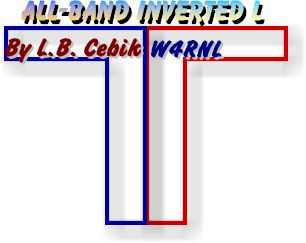

hen I wrote on "The L-Antenna" for 10-meters a few months back, I noted that the
antenna was not likely new. I have since learned that the basic idea seems to have
originated with VK3AM and is described in L. A. Moxon's (G6XN) classic HF Antennas
for All Locations (pp. 154-156 of the first edition). Ralph Holland, VK1BRH,
includes the L in his computer study of several antennas, including an interesting variant
of the L: the 1/2 wl inverted-L. (VK1BRH's interesting modeling studies, published in Amateur
Radio, the journal of the Australian Wireless Association, can be found at his web
site: (http://www2.dynamite.com.au/vk1brh/Antsim.htm) The inverted-L, using parallel
feedline and an ATU, is an antenna with excellent potential as an all-band substitute for
the 135' center-fed doublet.
The 1/2 wl inverted-L differs from standard 1/4 wl inverted-Ls in 2 ways: First, it is
longer, of course. Second, it is normally fed at the center. Hence, it can be viewed as an
inverted Vee tilted over by 45 degrees. Alternatively, it can be viewed as a
1-leg-ground-plane 1/4 wl vertical upside down.
If the upside-down vertical had a second leg going in exactly the opposite direction,
the result would be--to a large degree--cancellation of the horizontally polarized
radiation. Let's call this antenna the T.
Both the L and the T differ from the standard 1/4 wl ground plane vertical by being
complete antennas--dipoles as it were. Hence, neither requires a ground plane beneath
them. For some situations, this fact can simplify construction. The figure below shows the
structural differences among the three antennas for models set at 3.7 MHz. The L and T
models were set at a top height of 70', with the vertical arm terminated 4.5' off the
ground.
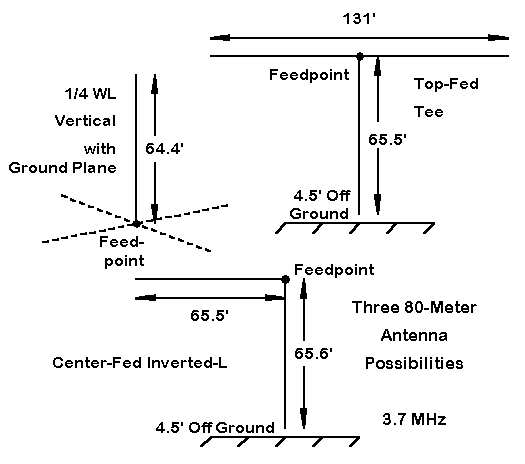
Each antenna was modeled using #14 copper wire and average ground throughout. Note that
the inverted-L and the T present challenges to the builder in terms of routing the
parallel feedline to the top feedpoint. We shall do some comparisons, but first, let's
become a bit more familiar with the inverted-L basic pattern.
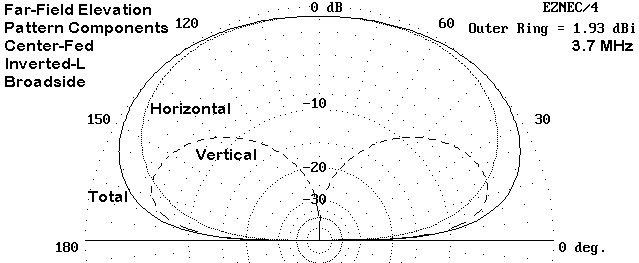
The elevation pattern above shows the vertical, horizontal, and total field components
of the inverted-L radiation pattern taken broadside to the horizontal arm of the antenna,
where radiation is strongest. In the plane off the ends of the horizontal arm,
horizontally polarized radiation is somewhat weaker, but the vertically polarized
radiation remains at full strength, with some pattern bending away from the horizontal
arm.
A fair comparison might be made among elevation patterns for the L, T, and vertical.
Since the total pattern of the L is a broad oval, let's take the strongest direction also
of the T, which happens to be off the ends of the horizontal arms. The vertical is truly
omnidirectional, so let's set at least 20 radials beneath it.
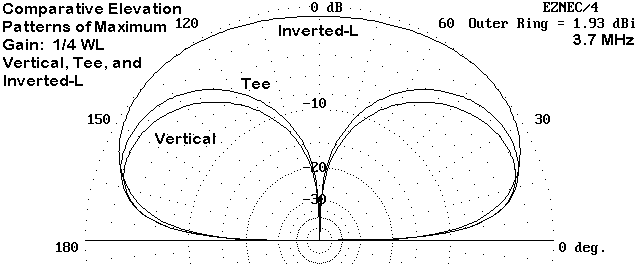
The comparative pattern above shows the rough equality of the T and the
ground-plane-vertical patterns under the specified conditions. Surprisingly, the
inverted-L comes close to both antennas in low angle radiation. It also has stronger high
angle radiation--without becoming a cloud burner--which is useful for shorter skip
contacts. In other words, the inverted-L has potential as an all-purpose low-band antenna.
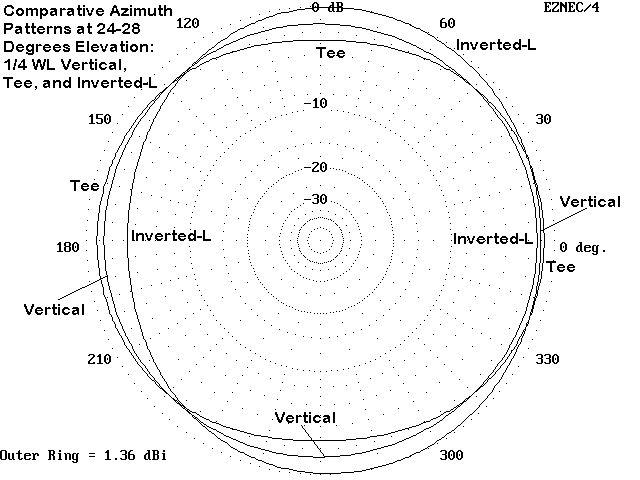
The azimuth patterns of the three antennas--taken at elevation angles between 24 and 28
degrees--show the slight oval of the T and the slightly more radical oval of the
inverted-L. The L's azimuth pattern also shows the slight displacement in the direction
away from the horizontal arm. However, these effects are small enough not to stand in the
way of using the antenna for general operating purposes.
The Ground-Plane Question
In principle, as a complete 1/2 wl antenna, the inverted-L requires no ground plane.
Likewise, the T should require none. In contrast, the 1/4 wl vertical requires a ground
plane to complete the antenna. To test the relative need and utility of a ground plane, I
modeled all three antennas with ground planes, first using 4 wires and then using 20
wires. I set each ground plane first at 1' below ground, then at the surface, and finally
at 1' above ground. The vertical's source segment touches the ground, which gives
erroneous results in NEC-4. Therefore, the surface ground plane for the vertical was set
0.1' above ground. The radial wires were the same length as the vertical radiators, which
means slightly shorter radials for the vertical than for the L or T.
The following table summarizes results for the three antennas with 4 and 20 wire ground
planes.
Antenna/GP level Gain TO angle Source Impedance
dBi degrees R +/- jX Ohms
4-radial tests
Inverted-L
No GP 1.93 44 66.1 + j 3.8
GP -1' 1.97 45 66.1 + j 4.5
GP 0' 1.96 44 66.0 + j 4.0
GP +1' 2.03 46 65.6 + j 4.5
T
No GP 0.56 28 42.7 - j 5.2
GP -1' 0.61 28 42.7 - j 4.6
GP 0' 0.60 28 42.7 - j 5.0
GP +1' 0.58 28 42.3 - j 5.2
Vertical
No GP -0.78 24 48.2 + j 0.2
GP -1' -2.38 25 68.5 + j 8.1
GP 0' -0.79 25 45.5 + j32.5
GP +1' -0.21 24 39.6 - j 9.3
20-radial tests
Inverted-L
No GP 1.93 44 66.1 + j 3.8
GP -1' 2.11 45 65.4 + j 6.5
GP 0' 1.99 44 66.3 + j 4.4
GP +1' 2.10 46 64.5 + j 4.7
T
No GP 0.56 28 42.7 - j 5.2
GP -1' 0.81 28 41.9 - j 3.0
GP 0' 0.65 29 42.9 - j 4.7
GP +1' 0.62 28 41.3 - j 5.2
Vertical
No GP -0.78 24 48.2 + j 0.2
GP -1' -0.47 25 45.3 - j 0.9
GP 0' 0.02 24 37.1 - j 3.9
GP +1' 0.06 24 36.8 - j14.6
Although the tables give the most data, comparisons are more difficult than with a
graph.
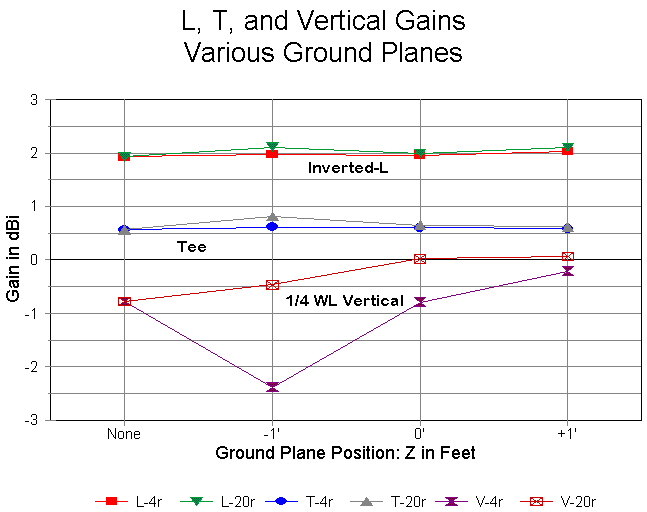
The antenna gains are compared in the graph above. The line connections between points
are not real connections, but only let the eye tell which data points go together. As is
evident, NEC-4 modeling strongly suggests that the addition of a ground plane adds
virtually nothing to antenna performance for the inverted-L and the T, both of which we
have described as complete antennas. In contrast, the vertical is dependent upon the most
extensive (up to 60-100 radials) that a builder can install. (The vertical antenna data
point for "No Ground Plane" should be used for reference and does not represent
accurate data relative to a real antenna.) I further modeled the vertical with 64 radials.
At a depth of 1', the antenna gain increased to 0.19 dBi, while setting them 1' above
ground yielded a gain of 0.02 dBi. Modeling has consistently suggested that for perfectly
symmetrical ground planes above ground, more than 6-8 radials may be superfluous. This
conclusion does not necessarily apply to ground planes that are not perfectly symmetrical.
An alternative to high-altitude center feeding of the inverted-L is to base feed it at
the low end of the vertical. Models of this mode of feeding the antenna show patterns
quite consistent with those for center feeding, with a source impedance in the
neighborhood of 5000 Ohms. Once more, the addition of a ground plane does not aid antenna
performance in any way, as the following elevation plot shows.
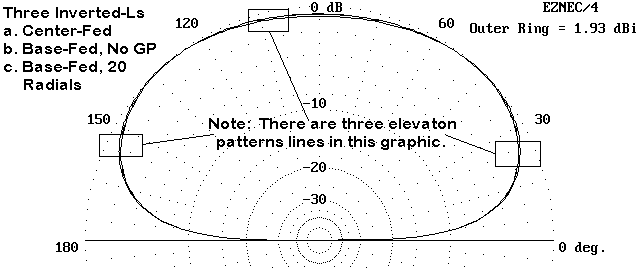
However, the absence of need for a ground plane should not be mistaken for an absence
of a need for a good RF ground. In turn, we should not presume that the ground rod near
the shack, which provides AC and DC power grounding for safety, also provides an adequate
RF ground. Army tests established a couple of decades ago that a good RF ground needs
periodic short (<2') rods connected by a perimeter wire or strap that essentially
surrounds the entire station location.
Installation Variations
Knowing that not everyone tempted to use the inverted-L will have all of the space needed,
I checked some variants that represent typical construction compromises or changes. Since
the antenna will be fed with parallel transmission line, matching is not a major problem.
However, changes of gain and elevation angle may indicate that some variations are better
than others.
<2') rods connected by a perimeter wire or strap that essentially surrounds the entire station location. Installation Variations Knowing that not everyone tempted to use the inverted-L will have all of the space needed, I checked some variants that represent typical construction compromises or changes. Since the antenna will be fed with parallel transmission line, matching is not a major problem. However, changes of gain and elevation angle may indicate that some variations are better than others.
1. Height: elevating the inverted-L is a route to slightly more gain
and a lower take-off angle broadside to the horizontal arm. Here is a table of values
modeled with top heights at every 5' from 70 to 100 feet up.
Top Ht. Bottom Ht. Gain TO Angle Feed Impedance
feet feet dBi degrees R +/- jX Ohms
70 4.5 1.93 44 66.1 + j 3.8
85 9.5 2.20 42 62.8 - j 4.2
80 14.5 2.43 41 60.1 - j 9.3
85 19.5 2.63 38 57.6 - j12.8
90 24.5 2.83 37 55.3 - j15.4
95 29.5 3.02 34 53.0 - j17.2
100 34.5 3.22 33 50.9 - j18.5
Nothing drastic happens between any two levels, but the trends are clear. Gain
increases and take-off angle decreases. The antenna plays shorter, the higher we go.
However, unless one plans to use a monoband coax feed system, the precise dimensions are
not at all critical.
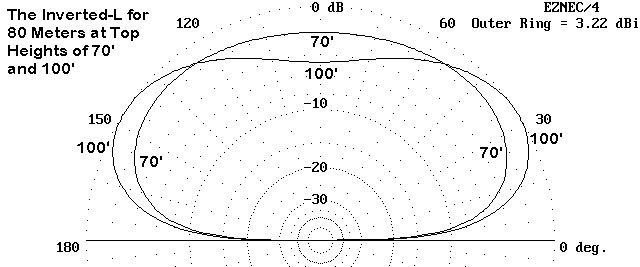
The elevation patterns in the figure compare the antenna at 70' and at 100' and add
visual confirmation of the conclusion drawn from the table. 2. Sloping and Bending:
The more normal problem for home installation is too little vertical or horizontal space.
As the figure below shows, there are a number of installation "tricks" we might
use. The question at hand is how much each will hurt performance.
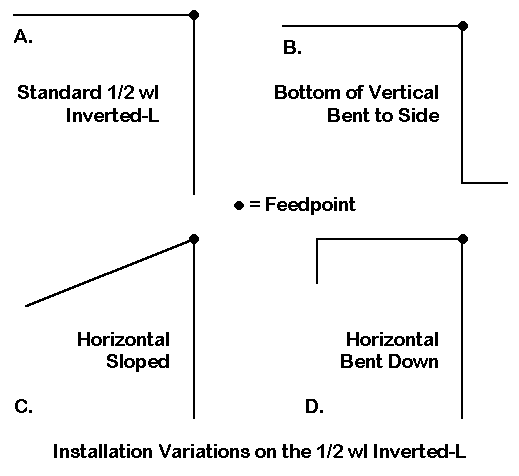
Bending the vertical at the bottom: The first way to save vertical space or to
protect family members from the high voltage at the antenna element end is to bend the
lower end of the vertical to the side. The upper horizontal arm remains 65.5' long. The
overall length of the vertical is also 65.5', but part is now vertical and part
horizontal. I tested three scenarios, listed in the table below:
Max. Ht Vert. Wire Low Hor. Gain TO Angle Feed Impedance
feet feet feet dBi degrees R +/- jX Ohms
70 60 5.5 2.04 45 64.2 - j 4.4
70 55 10.5 2.22 47 61.8 - j11.3
65 55 10.5 1.92 49 64.8 - j 2.7
The chief effect of the bend is to raise the high angle radiation strength a small bit
and to raise the elevation angle of maximum radiation. The latter figure indicates a
slight loss in the lowest angle radiation, which one would anticipate from shortening the
vertical length. None of these small changes in dimension affect the usableness of the
antenna.
Sloping the horizontal arm down: One might wish to use the antenna where there
is only one truly tall support and the support for the far end of the horizontal arm is
lower. The result is a sloping horizontal arm. Using a peak height of 70' and keeping the
dimensions of each wire at 65.5', I tested 2 scenarios, representing two degrees of slope,
against the standard installation.
Max. Vert Ht Hor. End Ht Gain TO Angle Feed Impedance
feet feet dBi degrees R +/- jX Ohms
70 70 (no slope) 1.93 44 66.1 + j 3.8
70 60 2.26 51 58.6 + j 8.4
70 50 2.66 58 52.4 + j32.0
Gain increases are at high angles of radiation, with some loss of low angle radiation
strength. Although a true horizontal is perhaps the best compromise for maximum low and
high angle performance, the patterns with a modest slope to the horizontal arm do not make
the antenna unusable by any means.
Bending the horizontal arm far end down: If horizontal space is limited, a
common practice is to bend (or dangle) the outer ends of a dipole downward. since the
region is the high voltage and low current portion of the antenna, the radiation pattern
is least affected by modifying the geometry. Again, I compared 2 scenarios to the full
length horizontal arm configuration.
Max. Ht Hor. Arm Lth Bent Length Gain TO Angle Feed Impedance
feet feet feet dBi degrees R +/- jX Ohms
70 65.5 0.0 1.93 44 66.1 + j 3.8
70 55.5 10.0 1.82 45 62.7 - j 5.9
70 45.5 20.0 1.62 43 54.6 - j12.2
Low angle radiation remains essentially constant, since the vertical arm has not been
altered. Further shortening of the horizontal arm would show a gradual further reduction
in maximum gain and in the take-off angle. Higher-angle radiation is decreased, although
the antenna remains eminently usable.
Like many wire antennas, the inverted-L will tolerate moderate alterations of geometry
to fit the space available and still yield good, if not peak, performance.
Multi-Band Use of the Inverted-L
One disadvantage of the 135' horizontal doublet when used on the upper HF bands is that
the pattern breaks into a collection of fairly narrow lobes with deep nulls between them.
Since the nulls change position from band- to-band, the user is often surprised to
discover that signals from certain directions are weaker than expected.
The inverted-L, when fed with parallel transmission line and an antenna tuner, is not
wholly exempt from this phenomenon. However, since one arm is fully vertical, the nulls
tend to be much shallower. At the same time, gain peaks are less pronounced.
The following table provides a rough guide on what to expect from each of the amateur
HF bands:
Frequency Gain To angle Feed Impedance Pattern Shape
MHz dBi degrees R +/- jX Ohms (approximate)
3.7 1.93 44 66 + j 4 Broadside oval
7.1 4.09 26 6500 + j 300 Broadside oval
10.1 4.04 20 150 - j 500 Square
14.1 5.38 14 2000 + j2300 4 lobes
18.1 6.99 33 165 - j 255 Square
21.2 6.74 9 750 + j1400 6 lobes
24.9 6.63 8 210 - j 520 6 lobes
28.5 7.55 7 575 + j1000 8 lobes
Even harmonics of the antenna's fundamental frequency show high impedances, in some
cases with a high reactive component. The WARC bands show more moderate impedances at the
antenna feedpoint. Use of 450-Ohm or 600-Ohm parallel feedline is recommended in order to
provide reasonable values of impedance at the antenna tuner terminals. As with all such
antennas, if a tuner seems unable to effect a match on a given band, adding a short
section of feedline between the existing line and the tuner output terminals will often
correct the situation.
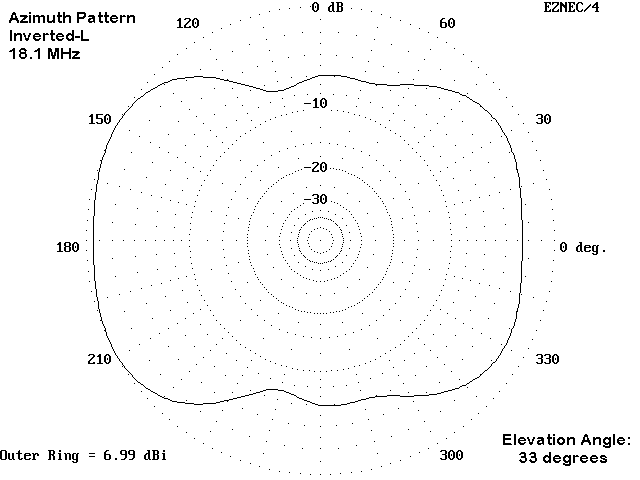
The annotation "square" to describe the azimuth pattern is illustrated by the
18.1 MHz pattern. On this band, the strongest signal occurs at the second elevation lobe.
There is a usable but less strong lobe at about 16 degrees elevation. Note the absence of
sharp nulls and lobes.
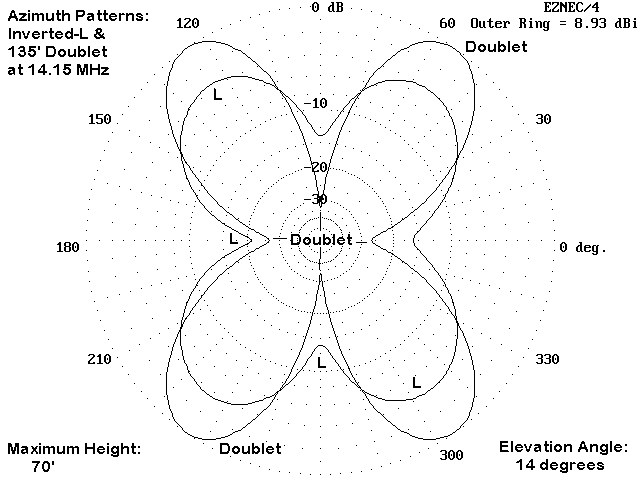
Even where lobes and nulls do occur, both are much less pronounced than they are with a
standard doublet. The figure shows the differences for the 20-meter band. Doublet nulls
exceed -25 dB relative to the lobes, whereas inverted-L nulls are under -10 dB relative to
the lobes, which are also broader than those of the doublet. Of course, peak gain of the
lobes is about 4 dB less than for the doublet lobes. For some types of operation, but
certainly not for all, the absence of strong nulls can be more advantageous than a few
extra dB of gain in very specific directions.
Conclusion
The inverted-L has the potential to be a quite satisfactory all-band wire antenna suited
to certain environments. Of course, versions cut for a fundamental frequency in the
40-meter band will also work. The pattern table can be adjusted roughly by sliding the
gain values and pattern descriptions down by one harmonic unit.
There is little evidence, despite the vertical position of one arm of the antenna, that
the inverted-L would benefit from a ground plane beneath the antenna. The actual low-angle
gain of the inverted-L will, however, vary with the quality of the soil in the region of
reflection at a distance from the vertical arm. All patterns were taken over average soil,
and soils that are either poor or better than average will tend to show a higher gain and
lower take-off angle, at least on the fundamental frequency.
The electrical lineage of the inverted-L is from the dipole by way of the
inverted-Vee. For the amateur yard that is short on horizontal space but long on tall
supports, the inverted-L may be the antenna of choice as an all-band wire--whether used as
the primary station antenna or as the back- up for more complex arrangements. -30-












